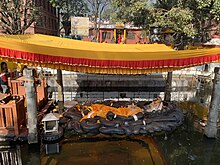
Summary
Budhanilkantha Temple, located in Budhanilkantha, Nepal, (Nepali: बुढानिलकण्ठ मन्दिर; translation: Old Blue Throat) is a Hindu open air temple dedicated to Lord Mahavishnu. Budhanilkantha Temple is also known as the Narayanthan Temple, and can be identified by a large reclining statue of Lord Mahavishnu.
| Budhanilkantha Temple | |
|---|---|
बूढानीलकण्ठ मन्दिर | |
 | |
| Religion | |
| Affiliation | Hinduism |
| District | Kathmandu |
| Province | Bagmati |
| Deity | Lord Vishnu / Buddha |
| Location | |
| Location | Budanilkantha |
| Country | Nepal |
| Length | 5 metres |
Religious Significance edit
Some people associate Budhanilkanth's name with Gautama Buddha since it pronunciation being closely similar but this is not a correct fact. Though the temple is named Budhanilkantha, its name does not come from the Buddha; Budhanilkantha instead has a Sanskrit origin that means ‘Old Blue Throat’, a title of Lord Shiva that was given by gods after the Lord drank poison to save the world. The statue symbolizes Lord Vishnu, who is regarded as one of the 'Trimurtis', along with Brahma and Shiva.
The Hindu scriptures Bhagavata Purana, Vishnu Purana and the epics Ramayana and Mahabharata refer to Samudra manthan, which is directly related to the origin of Gosaikunda. According to legend the spring that feeds the pond in the Budanilkantha temple is connected to Gosaikunda which makes it to have a direct connection to the water source from Lord Shiva. This is the reason why its name is dedicated to Lord Shiva even though the statue is dedicated to Lord Vishnu since the water pond on which the statue lies, has its source to Gosaikunda dedicated to Lord Shiva which was the result of him drinking the poison and storing it in his throat resulting in him having blue throat.[1]
This temple is regarded as a sacred place for Hindus but is equally well venerated by Buddhists (who consider the murti to be Buddha).[2] It is considered as a sign of religious harmony that has existed in the region since ancient times .
Location edit
Budhanilkantha Temple is situated below the Shivapuri Hill at the northern end of the Kathmandu valley.[3] It is located in Budhanilkantha municipality of Kathmandu District. Its address is Golfutar Main Rd, Budhanilkantha 44600. The Budhanilkantha Temple is about 10 kilometres from Tribhuvan International Airport and is about 9 kilometres from Thamel.
Feature edit
The main statue is carved up on a single block black basalt stone.[4] The statue stands 5 meters tall (around 16.4 feet) and is positioned in the middle of a recessed pool of water, which is 13 meters (42.65 feet) long. He holds the Sudarshana Chakra, Club, a Conch Shell and a gem in his four hands.[1] He is well adorned with a crown engraved with multiple Kirtimukha images which can often be seen being overlapped by a silver crown. The statue is believed to be more than 1400 years old.[4] The temple's main statue of Budhanilkantha is considered the largest stone carving in Nepal.[5]
Festivals edit
The Budhanilkantha Temple has become the site where thousands of pilgrims visit when Haribondhini Ekadashi Mela takes place on the 11th day of the Hindu month of Kartika (October–November) every year.[6] This is a special ritual to wake up Lord Vishnu from his long sleep. A big fair is also held at the temple area every year on the auspicious occasions such as Ekadashis, Harishayani and Haribodhini of hindu lunar calendar which marks the 4-month sleeping period of Lord Vishnu.
The Mysteries surrounding the temple edit
The Legend of the Nepalese Monarchy edit
A legend states that King Pratap Malla (1641–1674) had a prophetic vision. In the vision it was claimed that the king was cursed. If he would visit then they would die prematurely. This vision resulted in him believing that the kings of Nepal would die if they visited the Budhanilkantha Temple.[7] Royal family members including the Nepalese monarchs after King Pratap Malla never visited the Temple in fear of the prophecy.[8]
Floating Statue edit
It was suggested for many years that the statue floats in the pool. Indeed, limited access to scientific rigour in 1957 failed to confirm or refute the claim but a small chip of the did confirm it to be silica-based stone but with a remarkably low density similar to lava rock.[9]
Origin of the statue edit
According to one story, a farmer and his wife once struck a finger while plowing the field, which caused it to start flowing blood from the finger into the ground. The idol was later placed in its current position.
Mirror Image edit
Local legend describes the existence of mirror-like image of Lord Shiva beside the statue in the water even though the statue faces upward towards the sky. The legends also claims that the mirror like image is seen on annual Shiva festival held every year in August.[10]
See also edit
References edit
- ^ a b कृष्णा (2020-04-07). "नेपाल का बूढानीलकण्ठ मंदिर जहाँ सोते हुए भगवान विष्णु शेषनाग पर विराजमान हैं". धर्मयात्रा (DharmYaatra) (in Hindi). Retrieved 2022-07-24.
- ^ Binod Ghimire (2000). Experience Nepal: A Travel Guide, p. 96. R.G. Publications.
- ^ "Ministry of Culture, Tourism and Civil Aviation - Government of Nepal". www.tourism.gov.np. Retrieved 2016-07-31.
- ^ a b "1400 Years old sculptural marvel of Sleeping Vishnu on a single stone". Detechter. 2016-12-21. Retrieved 2022-07-24.
- ^ "Budhanilkantha, Nepal - Lonely Planet". lonelyplanet.com. Retrieved 2015-09-14.
- ^ "Budhanilkantha". sacredsites.com. Retrieved 2015-09-14.
- ^ "नेपाल का प्राचीन मंदिर, राज परिवार इस डर से नहीं जाता दर्शन के लिए". Navbharat Times (in Hindi). Retrieved 2022-07-24.
- ^ "Budhanilkantha". Places of Peace and Power.
- ^ "വെള്ളത്തില് പൊങ്ങിക്കിടക്കുന്ന കരിങ്കല്ലില് കൊത്തിയ വിഷ്ണു വിഗ്രഹം, അറിയുമോ ഈ ക്ഷേത്രത്തെക്കുറിച്ച്!!". Zee News Malayalam (in Malayalam). 2021-02-13. Retrieved 2022-07-24.
- ^ "बेहद चमत्कारी है ये मंदिर, एक साथ विराजते हैं श्री हरि व भोलेनाथ". punjabkesari. 2022-05-12. Retrieved 2022-07-24.


